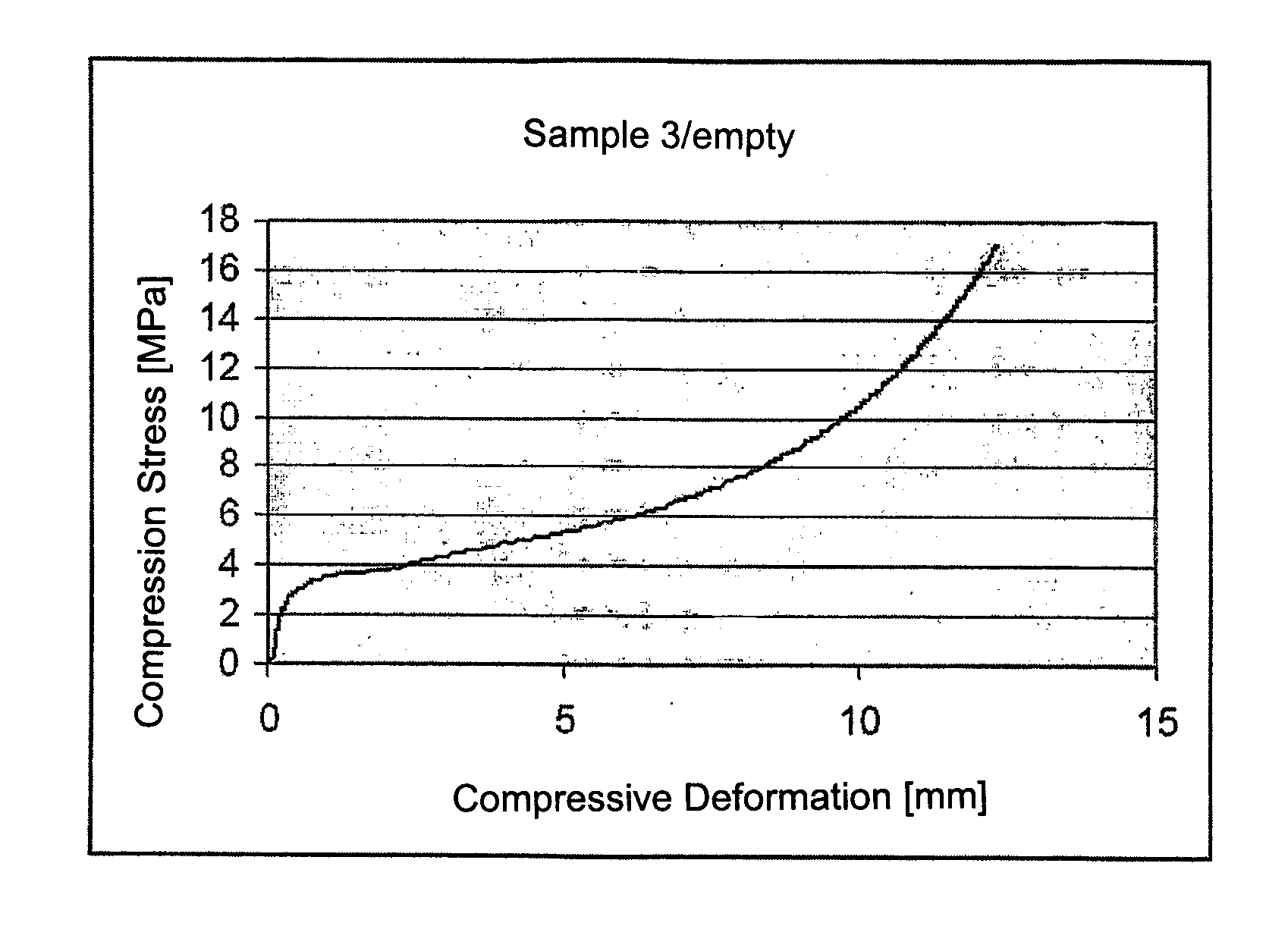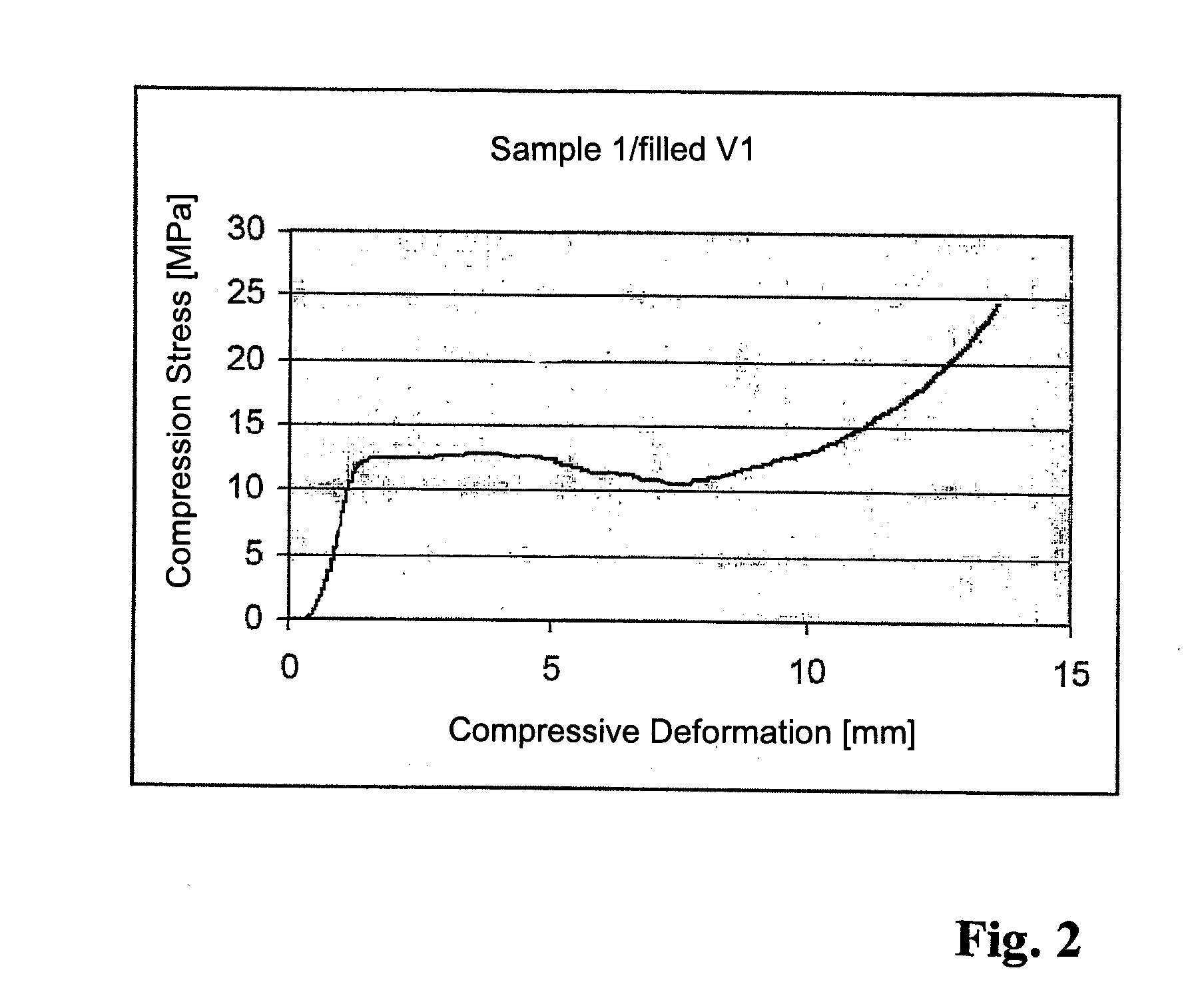Bone Implant, and Set for the Production of Bone Implants
a bone implant and set technology, applied in the field of bone implants and set for the production of bone implants, can solve the problems of inability to develop and manufacture bone implants with the aforementioned properties, lack of biomechanical adaptation, and inability to resorb the described material and in particular the aforementioned manufacturing process
- Summary
- Abstract
- Description
- Claims
- Application Information
AI Technical Summary
Benefits of technology
Problems solved by technology
Method used
Image
Examples
example 1
Bone Implant on the Basis of a Metal Foam Filled with Nano-Crystalline Hydroxyl Apatite
[0080]A metal foam of implant steel (360 L) is used that is produced by Fraunhofer Institut für Verfahrenstechnik and angewandte Materialforschung (IFAM Dresden, Adler et at, Sintered Open-Celled Metal Foams Made by Replication Method—“Manufacturing and Properties on Example of 316L Stainless Steel Foams”, in Cellular Metals and Polymers 2004, edited by R. F. Singer, et al, and John Banhart “Manufacture, characterisation and application of cellular metals and metal foams”; in Progress in Materials Science 46 (2001) 559-632) according to a powder-metallurgical method (pore size approximately 45 ppi / “pores per inch”). As a nano-crystalline hydroxyl apatite preparation a pasty preparation with 35% solids contents (in aqueous preparation) is employed.
[0081]The metal foam (diameter 3 cm, height 1 cm) is positioned on a filter paper above a glass frit in a tightly fitting plastic pipe (height 3 cm). Ont...
example 2
Bone Implant of the Basis of Metal Foam Filled with Calcium Phosphate Cement
[0083]The same metal foam as disclosed in Example 1 is used. As a filler calcium phosphate cement of own production with the following composition is used:
Powder Component:
[0084]60% TCP (fired at 1300 ground to a particle size of [0085]26% calcium hydrogen phosphate (anhydrous CaHPO4 [0086]10% calcium carbonate (CaCO3)[0087]4% hydroxyl apatite (precipitated),
all components are intensively mixed and ground together.
[0088]As a mixing solution, to a 2% sodium hydrogen phosphate (Na2HPO4) solution phosphoserine in a concentration of 50 mmol / l is added and subsequently the pH value is adjusted to 8.5. Subsequently, the powder component is homogeneously mixed with this mixing solution in a powder / liquid ratio of 0.7 at a temperature of 10° C. The obtained paste is uniformly applied onto the metal foam in an experimental set-up according to the Example 1 (without filter paper and glass frit in an airtightly sealabl...
example 3
Bone Implant on the Basis of a Hollow Sphere Metal Structure Filled with Nano-Crystalline Hydroxyl Apatite
[0090]As a porous metal structure cylinders of a diameter of 3 cm, height of 1 cm, are used that are comprised of hollow metal spheres, sintered together, with a size of the individual spheres of 1 mm in diameter. The employed material is implant steel (316 L) produced by Fraunhofer Institut für Verfahrenstechnik and angewandt Materialforschung (IFAM Dresden) in accordance with a powder-metallurgical method. In the same experimental set-up as in 1, a paste of nano-crystalline hydroxyl apatite with a solids content of 35% is introduced into the pore system of the metal cylinder. After loading the same procedure as in Example 1 is followed.
PUM
| Property | Measurement | Unit |
|---|---|---|
| flexural strength | aaaaa | aaaaa |
| flexural strength | aaaaa | aaaaa |
| flexural strength | aaaaa | aaaaa |
Abstract
Description
Claims
Application Information
 Login to View More
Login to View More - R&D
- Intellectual Property
- Life Sciences
- Materials
- Tech Scout
- Unparalleled Data Quality
- Higher Quality Content
- 60% Fewer Hallucinations
Browse by: Latest US Patents, China's latest patents, Technical Efficacy Thesaurus, Application Domain, Technology Topic, Popular Technical Reports.
© 2025 PatSnap. All rights reserved.Legal|Privacy policy|Modern Slavery Act Transparency Statement|Sitemap|About US| Contact US: help@patsnap.com



